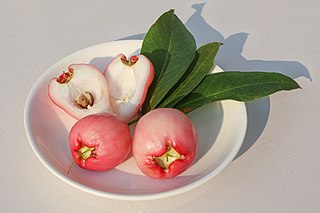
Syzygium samarangense is a species of flowering plant in the family Myrtaceae, native to an area that includes the Greater Sunda Islands, Malay Peninsula and the Andaman and Nicobar Islands, but introduced in prehistoric times to a wider area and now widely cultivated in the tropics. Common names in English include wax apple, Java apple, Semarang rose-apple and wax jambu. It is very common in the Southern Indian state of Kerala, where it is known as chambakka.
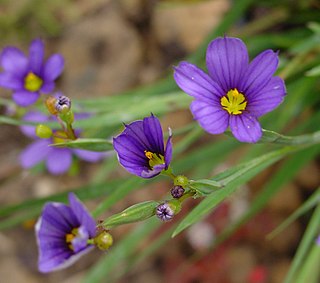
Sisyrinchium is a large genus of annual to perennial flowering plant in the family Iridaceae. Native to the New World, the species are known as blue-eyed grasses and, though not true grasses and in varieties with flower colors other than blue, are monocots.

Olsynium is a genus of summer-dormant rhizomatous perennial flowering plants in the iris family Iridaceae, native to sunny hillsides in South America and western North America.

Trillium pusillum is a species of flowering plant in the family Melanthiaceae known by the common names dwarf trillium, least trillium and dwarf wakerobin. It is native to the southeastern and south-central United States from Oklahoma to Maryland.
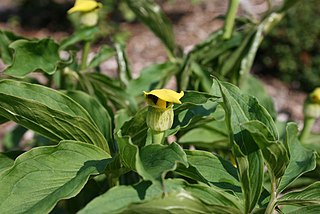
Arisaema flavum is a species of flowering plant widespread across north-eastern Africa and southern Asia. It is native to Ethiopia, Somalia, the Arabian Peninsula, Pakistan, Afghanistan, Nepal, Assam, Himalayas, Tibet, Yunnan, and Sichuan. The species epithet flavum is Latin for yellow and indicates its flower colour.
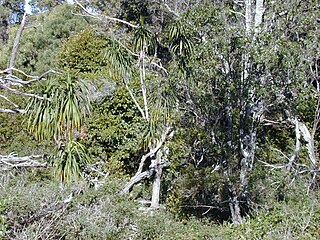
Dracaena aurea, the golden hala pepe, is a species of flowering plant that is endemic to the island of Kauaʻi in Hawaii. It inhabits coastal mesic and mixed mesic forests at elevations of 120–1,070 m (390–3,510 ft). It is a small evergreen tree, usually 4.6–7.6 m (15–25 ft) tall, but sometimes reaches 12 m (39 ft). The gray, straight trunk does not have bark and is 0.3–0.9 m (0.98–2.95 ft) in diameter. The sword-shaped leaves are 20–51 cm (7.9–20.1 in) long and 1–3 cm (0.39–1.18 in) wide.

Dendrobium bigibbum, commonly known as the Cooktown orchid or mauve butterfly orchid, is an epiphytic or lithophytic orchid in the family Orchidaceae. It has cylindrical pseudobulbs, each with between three and five green or purplish leaves and arching flowering stems with up to twenty, usually lilac-purple flowers. It occurs in tropical North Queensland, Australia and New Guinea.

Dendrobium discolor, commonly known as antler orchids, are epiphytic or lithophytic orchids in the family Orchidaceae. They have cylindrical pseudobulbs, each with between ten and thirty five leathery leaves, and flowering stems with up to forty mostly brownish or greenish flowers with wavy and twisted sepals and petals. Antler orchids occur in northern Australia, New Guinea and Indonesia and there are several subspecies and varieties.
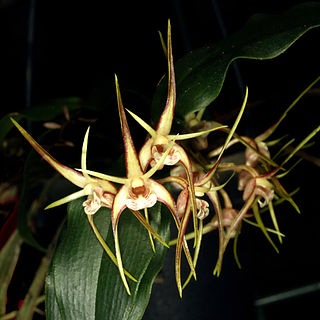
Dendrobium tetragonum, commonly known as the tree spider orchid, is a variable species of epiphytic or lithophytic orchid endemic to eastern Australia. Tree spider orchids are unusual in having pendulous pseudobulbs that are thin and wiry near the base then expand into a fleshy, four-sided upper section before tapering at the tip. There are only a few thin but leathery leaves at the end of the pseudobulbs and up to five flowers on relatively short flowering stems. To allow for the variations in the species there are five subspecies and a variety, some with a unique common name.
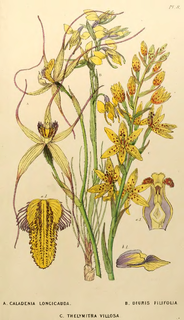
Diuris filifolia, commonly known as the cat's face orchid, is a species of orchid which is endemic to the south-west of Western Australia. It is one of the rarest Diuris in Western Australia, sometimes flowering in large numbers but only after hot summer fires.

Eulophia pulchra, commonly known as the gonzo orchid, is a plant in the orchid family and is native to areas from Tanzania and Mozambique to the Western Pacific Ocean. It is a terrestrial orchid with crowded, above-ground pseudobulbs, two or three leaves and pale yellowish green flowers with dull purple or red markings. It grows in plant litter in rainforests.
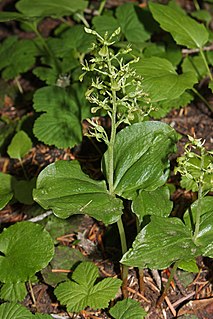
Neottia banksiana is a species of orchid known by the common name northwestern twayblade. It was formerly placed in the genus Listera, but molecular phylogenetic studies have shown that Neottia nidus-avis, the bird's-nest orchid, evolved within the clade formerly containing only Listera species, so all species of Listera have been formally moved to Neottia, the older genus. Some continue to refer to this species by its previous genus; older scientific names include Listera banksiana and Listera caurina.

Bromheadia finlaysoniana, commonly known as the pale reed orchid and as Bromheadia pulchra in Australia, is a plant in the orchid family and is native to areas from Indochina to northern Australia. It is a terrestrial orchid with a tough upright, stem and stiffly spreading, elliptic to egg-shaped leaves. There is a long flowering stem with a short zig-zag section near the end where single flowers open in succession. The flowers are white with a yellow labellum.

Melaleuca pallida, commonly known as lemon bottlebrush, is a plant in the myrtle family, Myrtaceae and is endemic to eastern Australia. It is an upright shrub with thin, spreading branches, silvery new growth and pale yellow, sometimes pinkish bottlebrush flowers.
Craspidospermum is a monotypic genus of plant in the family Apocynaceae endemic to Madagascar. As of August 2013 the World Checklist of Selected Plant Families recognises the single species Craspidospermum verticillatum.
Pycnobotrya is a monotypic genus of plant in the family Apocynaceae found in tropical Africa. As of August 2013 the World Checklist of Selected Plant Families recognises the single species Pycnobotrya nitida.
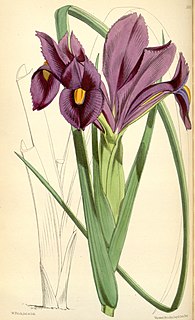
Iris filifolia is a species in the genus Iris, it is also in the subgenus Xiphium. It is a bulbous perennial from North Africa and Europe. It has thin leaves, summer flowers in shades of red-purple.
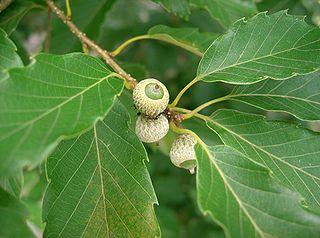
Quercus serrata, the jolcham oak, (Chinese: 枹栎; pinyin: bāolì, 小楢 is an East Asian species of tree in the beech family. It is native to China, Taiwan, Japan, and Korea.

Sisyrinchium bermudiana, known as Bermudiana or, along with other members of the genus, as blue-eyed-grass, is a flower of the genus Sisyrinchium that is indigenous to the Atlantic archipelago, and British Overseas Territory, of Bermuda. The plant appears and blooms in the spring. It has been used as a totemic flower by Bermudians, and appears in art, jewellery, banknotes and elsewhere. Long believed to be limited to Bermuda, the plant has also been found around Lough Erne and Lough Melvin in County Fermanagh, Northern Ireland, where it is known as feilistrín gorm, or blue-eyed grass.

Hypericum przewalskii, commonly called Przewalski's St. John's wort, is a flowering plant in Hypericumsect. Roscyna that is native to China.

















